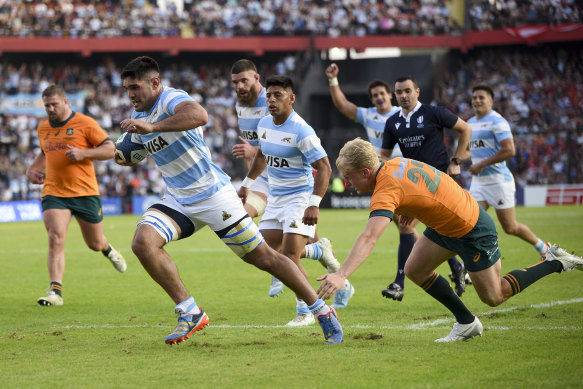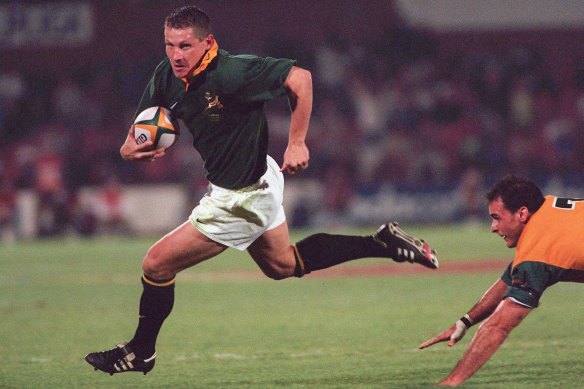- Analysis
- Sport
- Rugby Union
- Wallabies
This was published 7 months ago
After record Wallabies defeat, there are no pitchfork-wielding mobs. Is that a good or bad sign?
By Iain Payten
Like a flash flood, the Wallabies’ demise in Santa Fe was fast, frantic and overwhelming. From the warm bosom of a 20-3 lead, the Wallabies then conceded 64 points in the next 50 minutes.
Argentina scored seven tries in the second half and four in the last 10 minutes alone. In the last quarter, the Wallabies spent more time standing behind their posts than they did in the Pumas’ 22.
The 67-27 loss was the first time Australia had ever conceded 50 points in a half, and surpassed the 61-22 defeat to South Africa in 1997 as Australia’s highest points total conceded.
But like a flash flood, the carnage came and went suddenly, leaving bewildered Australian fans looking at each other with a “what the hell just happened?”
Ever-sanguine coach Joe Schmidt said the long flight home would give the Wallabies squad plenty of time to soul-search. He might have even mandated a few hours of raw-dogging to ensure it.
But the trans-Pacific autopsy will have also begun in earnest. Hopefully they’ll share the findings, because the stats sheet doesn’t flash up “record defeat” in neon letters.

Argentina’s Joaquin Oviedo runs with the ball to score a try against Australia. Credit: AP
Territory and possession were only just in Argentina’s favour, and the Pumas had the ball in attack for 17 minutes to compared to the Wallabies’ 14. Set-pieces were all square (even slightly in Australia’s favour) and the Wallabies only missed 23 tackles to Argentina’s 20, with 84 per cent effectiveness.
Obviously, though, it’s what Argentina did with the ball that mattered – and, digging a little deeper, the Pumas’ dominance of Australia’s backpedalling defence is there to be seen. The hosts made 18 offloads to Australia’s four, made 16 clean breaks to seven and crossed the gain line with 52 per cent of 165 carries (a season’s best).
And so, too, the Wallabies’ game unravelling: the team conceded seven penalties and 10 turnovers in the second half (the total of 17 turnovers was a season’s worst). Argentina also beat 12 defenders in the last quarter.
Put simply, the Wallabies were cooked in the sun after about 30 minutes, and the relentless pace of the Pumas’ game sapped their legs so much, it looked like Santa Fe – at 25m above sea level – was in the thin air of the Andes.
It must be stated that it’s well overdue for respect to be put on Argentina’s name. The Pumas have played in the semi-finals in three of the last five World Cups – including 2023 – and with a majority of players brought through the now-defunct Jaguares in Super Rugby, they’ve beaten the All Blacks twice in New Zealand since 2020 – something the Wallabies haven’t done since 2001.
But just as the modern cliche goes, the Wallabies will need to “focus on our own game”.
Experts and former players have pointed to a range of panicky sins in the ‘Santa Fe 50’: poor restart skills, poor discipline in own half, simplistic one-out attack and poor ‘exits’ – skill and strategy.
Defensive plans demand scrutiny. In an excellent post-mortem on the Between Two Posts podcast, former Wallabies halfback Nick Phipps remarked on the Australian defence strategy being static and connected, at a time where most teams are aggressively blitzing. It works if you slow the ruck with a two-man tackle but on a day like Sunday, single-person, low-chop tackling lead to “leaking and more leaking” – and then an inevitable flood of momentum, offloads, overlaps and tries.
The question of leadership under pressure is also germane: namely why Australia didn’t put their foot on the ball and slow the pace by kicking over the moat and into the stands, and backing a defensive lineout.
There is a weekend off to pore over all the issues before the first Bledisloe Cup in Sydney, and perhaps luckily for Rugby Australia, the first afternoon kickoff since 1995 had already seen strong ticket sales. A crowd of 65,000 is forecast.
But of all the issues arising from the record loss in Santa Fe, the one that will make Rugby Australia most nervous is the reaction. Or, to be more accurate, the lack of it.
Online and on sports talkback, there has been a glaring absence of villagers brandishing torches and pitchforks. There has been no calling for heads on a pike. Amazingly, for rugby, there hasn’t even been a strongly worded letter from angry ex-captains.
After the Wallabies were beaten 61-22 in Pretoria in 1997, the sacking of coach Greg Smith was just about sorted by the time they landed back in Sydney. Furious CEO John O’Neill went on record about the “devastating defeat” and questioned players’ attitudes.

James Small eyes the line as he slips past David Wilson in the Springboks’ 61-22 win over the Wallabies in 1997.Credit: AP
Given the cards he was handed, there is no prospect of Schmidt being sacked. And nor should there be. While a record loss could see some players’ careers in question, with the depth problems in Australian rugby (and a Lions tour around the corner), the only course is to keep ploughing on.
And broadly speaking, the verdict from weary Wallabies diehards is acknowledgement a rebuild after a decade of decline is going to include this sort of pain. Before a 50-point second half, there had been good footy in three out of four quarters in Argentina.
“Trust the process” is the cry, and some optimists even point to the 1997 Wallabies going from Pretoria to a Rugby World Cup win within two years, with just a few added players. Those players were handy types, however: Tim Horan, John Eales, Matt Burke, Toutai Kefu and David Giffin.
The more dangerous question for Rugby Australia is what’s behind the lack of reaction to a record loss for the Wallabies from the wider sporting public.
While they never enjoy the attention of a pitchfork mob, sporting bosses will tell you they’d much prefer anger than the real killer – apathy.
Watch all the action from The Rugby Championship with every match streaming ad-free, live and on demand on Stan Sport.